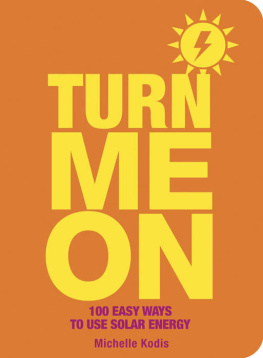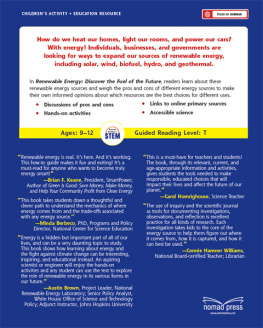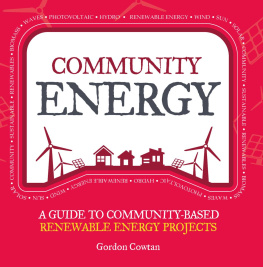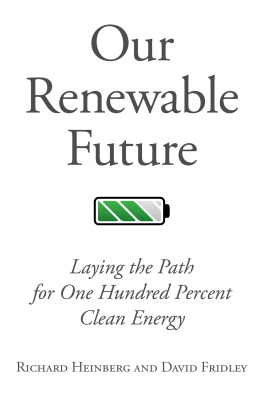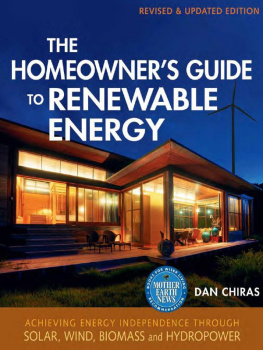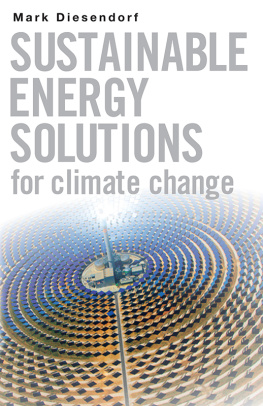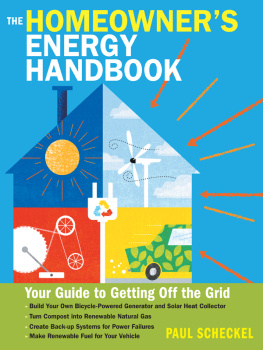My deepest appreciation and gratitude to: Suzanne Taylor, Michelle Witte, Gibbs Smith, Christopher Robbins, Hollie Keith, Madge Baird, Bob and Joan Kodis, Rosemerry, Kendall, Anne, Maureen, Kierstin, Pam, Marcia, Andrew, Brett, Violet, and Renzo.
Introduction
Each month, those of us who live on the grid get a little gift in the mail: an invoice for our electricity usage. Prior to that bill arriving, the little meter attached to our homes has been spinning day and night, tallying our energy use as we power up our computers, stuff our wet towels into the dryer, forget to turn off the lights when we leave a room, pop in a DVD, fire up the coffee-maker, and so on. Our debt to the power company can fluctuate depending on the season. In winter, of course, we cant do without that toasty electric blanket, right? When indeed the bill is higher in the winter months, we sigh, thinking that we really should start finding ways to reduce our fossil fuel consumption and do our part for the planetbut it all seems so... complex and time-consuming, and we dont know where to start. We write the check and its on to next month. Click. Click. Click. Thats the sound of the meter costing you money. Ready to learn about a new way? Read on.
Currently, the United States is a fossil fueldependent nation. We could not function without the grid, the intricate and vast network of electrical utility distribution. When you hear about a person who lives off the grid, this means he or she has either fully or partially ended dependence on the grid for energy by substituting alternative means of generating power. While Turn Me On does not aim to get you grid-independent by early next week, we do hope it will provide the inspiration and impetus to learn more about the wayssome of them very, very easy and very, very freeto end total reliance on diminishing fossil fuels.
I wholeheartedly thank and salute you for choosing this book. In doing so, you have joined an unstoppable global movement that is transforming, at seemingly warp speed, how we view the inherent limitations of our precious natural resources. That movement is giving us intelligent and innovative new choices for how we conduct our lives. Maybe you already know a thing or two about solar power, or perhaps youve chosen this book to begin building a knowledge base to get you started on a more in-depth path toward renewable energy. Whatever your individual experience or goal, I hope Turn Me On helps you develop a passion for solar power that you will pass on to others.
As the third title in Gibbs Smiths series of eco handbooks (the first two, Its Easy Being Green and Go Green, have enjoyed much-deserved success), Turn Me On is a lively and educational glimpse at all things solar. In these pages, youll find everything from descriptions about the latest and greatest technology to how to use a simple solar oven. From the outset, my goal in compiling this body of information was to give you as many ideas and tidbits for thought as possible without overwhelming you with too much technical detail and data. My guess is that after reading Turn Me On youll be craving a deeper understanding of both technology and policy, and youll find plenty of additional reading suggestions in these pages.
Turn Me On does not have a fancy table of contents or clever organizational tactics. It is a straightforward, sequential, 1 to 100 journey of ideas, insights, technology, science, collaboration, inspiration, surprises, guidance, and, even, pop culture. And, it has been designed to guide you through the information as effortlessly as possible; for that I am indebted to the talented graphic designer, Linda Herman, who took my words and shaped them into a cohesive book that I hope will have a positive influence on your life, and on the lives of those around you.
The snappy title, courtesy of Gibbs Smith vice president and editorial director, Suzanne Taylor, and the cheerful art on the cover and throughout the text, clearly indicate that we are having some fun with this topic. Were not going to go into any heavy detail. We promise you we wont get pedantic or pushy. This handbook is a springboard. Use it, share it, add to it using the blank journal pages at the end of the book. Heres the deal, folks: environmentalism does not have to be a heart-heavy endeavor in which the constant reminder of a planet in peril permeates our collective daily mood. Quite the opposite. There is great hope to be had as this book enters the marketplace. Across the world, great thinkers, innovators, and leaders are searching for and discovering ways to shift to clean, renewable energy. Every day, it seems, a new development or trend in sustainability and alternative energy arrives, reminding us to always look on the bright side of things.
Michelle Kodis
1. Should You Care About Carbon?
The following essay, Why Carbon Matters, is courtesy of Carbon Monitoring for Action (CARMA), www.carma.org. Through its massive database of information on the carbon emissions of more than 50,000 power plants and 4,000 power companies worldwide, CARMA aims to equip individuals with the information they need to forge a cleaner, low-carbon future. CARMA is produced and financed by the Confronting Climate Change Initiative at the Center for Global Development, an independent and non-partisan think tank located in Washington, D.C. This essay is an excellent explanation of why renewable energy sources are more crucial than ever to the sustained health of the planet. (This essay is reprinted with permission from the Center for Global Development, www.cgdev.org / www.carma.org. )
The bulk of humanitys energy needs are currently met through the combustion of fossil fuels like coal, oil, and natural gas. About 60 percent of global electricity generation relies upon fossil fuels to make the heat needed to power steam-driven turbines. Burning these fuels results in the production of carbon dioxide (CO2)the primary heat-trapping greenhouse gas responsible for global warming.
Over the past two centuries, mankind has increased the concentration of CO2 in the atmosphere from 280 to more than 380 parts per million volume, and it is growing faster every day. The atmospheric concentration of CO2 has not been this high for at least the past 650,000 years. As the concentration of CO2 has risen, so has the average temperature of the planet. Over the past century, the average surface temperature of Earth has increased by more than 1.3F (0.74C). If we continue to emit carbon without restraint, temperatures are expected to rise by an additional 6F (3.4C) by the end of this century.
Climate change of that magnitude would likely have serious consequences for life on Earth. Sea level rise, droughts, floods, intense storms, forest fires, water scarcity, and cardio-respiratory and tropical diseases would be exacerbated. Agricultural systems would be stressedpossibly decimated in some parts of the world. A conservative estimate suggests that 30 percent of all species are at risk of extinction given current trends. It would be the greatest extinction of life on Earth since the K-T extinction event that destroyed the dinosaurs 65 million years ago. No one can imaginenever mind predictthe ecological consequences of such a radical loss of life.

